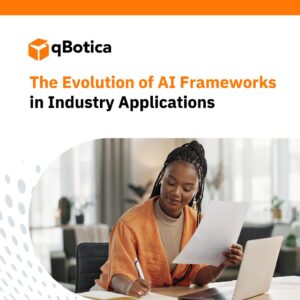Automation technology changes by the minute, making it challenging to understand which innovations can benefit your business today and in the future. At qBotica, our goal is to help you discover cutting-edge tools that are worth your investment and explain precisely how they work. To keep your business ahead of the curve, let’s take a look at the top automation trends for 2022.
1. COMPANIES WILL INVEST MORE IN AUTOMATION
In a recent Gartner survey, more than 80% of organizations said they’ll “continue or increase” automation spending in 2022. And those companies are poised to optimize performance and productivity radically. Companies that invest in a framework linking AI-based and traditional automation to connect a hybrid workforce of human and digital workers will gain a competitive advantage.
Survey respondents said they plan to focus on how automation systems can support revenue growth, new business opportunities, and innovation. They plan to invest in systems that include robotic process automation (RPA), digital process automation (DPA), intelligent document processing (IDP), and artificial intelligence (AI). General Electric and BMW, for example, plan to use 3D printing to revolutionize construction, while Amazon will start delivering packages via autonomous vehicles and drones.
2. RPA WILL WIN AS THE “SOUL” OF AUTOMATION
Automation may seem like a strictly technical field. Still, in 2022, robotic process automation (RPA) will stand out among other platforms as the heart and soul of how businesses start to implement their automation systems. RPA technology allows computer robots or “bots” to learn and perform repetitive tasks, such as filling out forms and processing paperwork, which frees up valuable hours for workers.
Most businesses implement RPA first to streamline their workflows, saving time and money. RPA technology integrates with complex automation systems, including intelligent document processing (IDP) and AI. For instance, businesses can incorporate RPA to process order forms and deliveries and add AI functionality to suggest products to customers. In 2022, RPA will take on platforms that require richer user interfaces and higher levels of AI, allowing companies to integrate RPA into their established processes better and use it to manage their existing technologies.
RPA may be the soul of automation, but it can’t skyrocket businesses into the future and automate everything all on its own. Companies also need to automate tasks that require a human touch, such as reading an email, answering a customer question, or deciding on loan approval. This is where intelligent automation such as IDP and AI will come into play. While RPA can complete rule-based tasks with speed and efficiency, intelligent automation uses machine learning (ML) to achieve more complex operations.
Machine learning is the science behind AI that allows computers to analyze data and recognize patterns similar to humans. With ML and AI, computer software can become more accurate and understand and make decisions. Experts say AI capabilities can lead to numerous innovations over the next year, from virtual healthcare platforms through CVS and Walgreens to digital baristas via Nestle Nespresso and Starbucks. In 2022, companies will expand their automation scope, focusing on adaptive and creative endeavors.
If you work in a large company, your team toggles through an average of over 170 different applications every day, from Word to Slack to Salesforce. This “swivel-chair” work takes valuable time away from more critical tasks.
In 2022, expect to see more organizations address this problem through digital desktop assistants. These software robots help employees automate repetitive tasks, like inputting data, while opening and closing programs and queuing tasks appropriately to eliminate wasted time.
In this automated virtual assembly-line system, instead of navigating across separate applications, software assistants will tee up a flow of just-in-time tasks for workers, with all the required programs already open and ready to use. What manufacturing assembly lines did for productivity, virtual assembly lines will do for the digital workforce.
Personal assistants won’t be the only jobs going digital in 2022. Expect to see service companies including restaurants, warehouses, and retail outlets invest more in robot workers, especially in locations and departments with the most demanding working conditions. For example, a robot worker can quickly scan inventory in cramped aisles or eliminate sanitation issues from food prep processes. Whether in physical robot or software bot form, automation will also help solve worker shortages and allow businesses to focus hiring and recruitment on higher-level positions.
Pipeline development is essential To implement any new process on a large scale, and automation is no exception. Businesses must answer questions like, What areas of the company could benefit most from automation? And How will automating paperwork for the sales team affect the accounting department? By 2022, this process of learning how to automate effectively will take a new turn with automated process discovery technologies.
One example is qBotica’s Disqover tool. Intelligent process discovery using Disqover helps companies with process mining and analysis to drive efficiency and get the most out of automation. Disqover can:
- Uncover most common processes automatically and quickly.
- Adapt to its environment and work with several third-party applications.
- Allow businesses to break down and visualize workflows in a computer setting—no rocket science or coding experience required.
- Detect hidden issues in data and investigate where and why problems occur through the AI-driven Disqover Root Cause Analysis Program.
- Gain objective certainty for more clarity and perspective on inefficiencies.
- Improve processes and take advantage of user interactions in real-time.
The world of technology moves fast, and automation is the key to staying ahead of the curve. Businesses over the next year will work to identify new avenues where automation and machine learning can help them reduce costs and innovate their current processes. The taxi industry might see ride-hailing services powered by autonomous vehicles, and medical companies could provide companion robots to assist the elderly. There are limitless possibilities to where continued growth in automation can take the world next.
Implementing or accelerating automation will continue bolstering business success in 2022 and beyond. By ensuring employees can focus on vital tasks and reducing overhead, businesses can invest in innovation and growth. Contact our automation experts at qBotica today to start crafting your automation vision for 2022.











